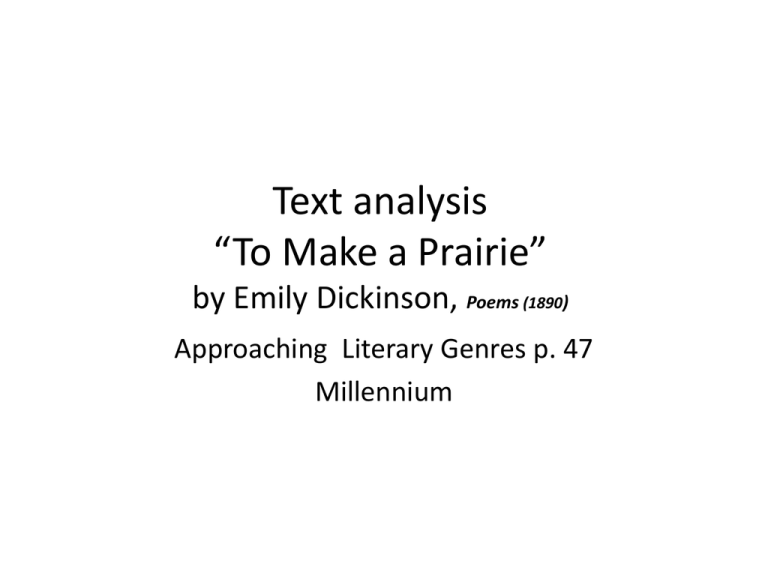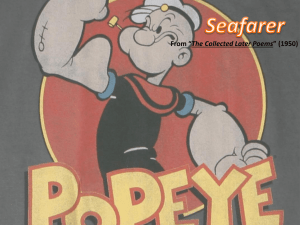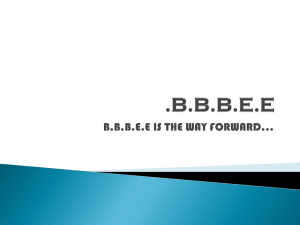To make a prairie it takes a clover and one bee
advertisement

Text analysis “To Make a Prairie” by Emily Dickinson, Poems (1890) Approaching Literary Genres p. 47 Millennium To make a prairie it takes a clover and one bee, One clover and a bee, And revery. The revery alone will do If bees are few. FOCUS ON THE To Make a Prairie MEANING 1. • 2. Can you explain, in your own words, the meaning of the first line? To make a prairie it is necessary to have just clover and a bee. Which of the senses may be struck by the clover and a bee?. Give reasons for your choice/s: Touch Hearing Sight Taste smell • The senses which may be impressed by clover and a bee are sight, since they can be seen and, in the case of the bee, also hearing, since one can hear its buzz. 3. Revery is a new element introduced by the author that can conjure up the presence of a prairie. Is it more important than the ones previously mentioned in the poem? Explain why (or why not). • Yes, it is. In line 4 it is said that “The revery alone will do”. The reality of dreams seems more “real” than reality itself. 4. How do you think the last line is to be taken? Give reasons for your choice/s; literally figuratively ironically Scientifically The last line is to be taken figuratively, as if to say that if reality is not too evident (i.e. “if bees are few”, l.5) the world of dreams can develop all its potential and its richness. The world of dreams seems to have a consistency of its own, in contrast with, or even in antithesis to, the physical world we live in. 5. • What do you think is the dominant mood of the poem ? Give reasons for your choice/s: loneliness curiosity sadness nostalgia happiness The dominant mood of the poem could be loneliness: the dreaming person is alone whith his/her reveries and separated from the rest of the real world. But we may feel that also nostalgia is present, a desire for a lost reality outside the world. Others may feel that also happiness is present: we don’t need many things to live pleasant experencies: all we need is the creative power of our imagination. • • FOCUS ON RHETORICAL 6. PATTERNS This apparently simple poem has a very carefully built rhythmic structure. The first line contains an internal rhyme. What is it? Highlight in yellow the examples where this sound / rhyme is repeated. • The internal rhyme in line 1 is ; “prairie / bee”. This sound is repeated in the following lines : “bee” (l. 2), “revery” (l.3), “The revery”(l.4). To make a prairie it takes a clover and one bee, One clover and a bee, And revery. The revery alone will do If bees are few. 7. Are these rhyming words important to the general meaning of the poem? • Yes, they are. The word “revery” is the key word of the poem. In fact, the poem is about the role of revery and imagination which make life less boring and more pleasant. 8. What do you think the elaborate sound pattern of the poem conveys? Give reasons for your choice/s : Dreaminess Monotony Joy Sleepiness The poem conveys dreaminess, a sense of estrangement from reality. But we may also feel joy for an imaginary life, a life created by the power of our imagination . 9. There are several repeated words in the poem, and their position is important: they create a pattern that is both rhethorical (combination of words) and rhythmic (combination of same or similar sounds). The repetition of “a clover” and “one bee” in lines 1 and 2 is almost identical, except for one detail. Write the words down in the blanks in the order in which they occur in the poem • Line 1 “a clover and one bee” • Line 2 “One clover and a bee” You will have noticed that, while the nouns are arranged in a parallel pattern (clover /bee , clover / bee), the accompanying articles are given an inverted or criss-cross pattern: a one one a • This rhetorical figure is called a chiasmus: a figure of speech in which words, grammatical constructions, or concepts are repeated in reverse order, in the same or a modified form.








